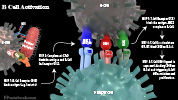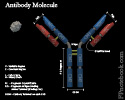Immunoglobulin, Antibody, Fragment Antigen Binding, Immunoglobulin Fab Fragment, Fragment Crystallizable, Immunoglobulin Fc Fragment, Ligand, Humoral Immunity, Immunoglobulin Constant Region, Immunoglobulin Variable Region, Immunoglobulin Heavy Chain, Immunoglobulin Light Chain, Immunoglobulin J-Chain, Clonal Selection Theory, Isotype, Allotope, Idiotype
- See Also
- Definitions
- Fragment Antigen Binding (Fab)
- Antibody region that recognizes and binds Antigens
- Fragment Crystallizable (Fc)
- Antibody region that interacts with Immune System components
- Endogenous Fc triggers Natural Killer Cells and complement cascade
- Synthetic monoclonal antibodies may bind Fc to toxins or radioisotopes in Chemotherapy
- Ligand
- Molecule that binds to a specific receptor
- Humoral Immunity
- Humoral Immunity (i.e. B-Cells and antibodies) targets extracellular pathogens
- Part of Adaptive Immunity (learned Immunity) in combination with cellular Immunity (T-Cell function)
- Isotype
- Individual Antibody groups (Immunoglobulin A, E, G, M and D)
- Allotope
- Isotype (Immunoglobulin A, E, G, M and D) variation specific to an individual
- Functionally insignificant changes in Antibody structure that differentiates Isotypes from one individual to another
- Idiotype
- Antigen receptor types found on Lymphocytes
- B Cell Idiotypes are identical to their corresponding antibodies
- T Cell Idiotypes vary considerably from their B Cell counterparts, but still respond to the same Antigen
- Physiology
- B-Cells
- Derivation
- Fetal Liver
- Bone Marrow Pluripotent Stem Cells
- Peripheral Migration to Secondary Lymphoid Tissue
- Spleen
- Lymph Nodes
- Peyer's Patches (Small Bowel)
- Clonal Selection Theory
- Immature Lymphocytes are generated from hematopoietic stem cells
- Lymphocytes mature into inactive Lymphocytes
- Lymphocytes differentiate to inactive Lymphocytes, each ready to respond to a limited set of Antigens
- Antibodies that recognize self Antigens are inactivate and destroyed (including during fetal development)
- Self Tolerance is critical to preventing Autoimmune Disease
- Foreign Antigen is encountered
- B-Lymphocyte is activated and multiple clones of the reacting Lymphocyte are made
- Each B-Lymphocyte produces a variety of slightly different antibodies against an Antigen
- Contrast with identical monoclonal antibodies produced in the lab, and by lymphocytic tumors
- Resources
- Activation
- Images
- Recognition
- Antigen binds B-Lymphocyte Surface Receptor (BCR)
- Protein Antigens
- Primary response (IgM mediated after 5-10 days)
- Secondary response (highly specific, IgG mediated after another 1-3 days)
- More specific response via T-Helper-mediated B-memory cell proliferation
- CarbohydrateAntigens
- Protein Antigens
- BCR binding activates B-Lymphocyte
- T-Cell Independent Antigen (e.g. inert Antigens) alone activate B-Cells
- T-Cell Dependent Antigen (e.g. Microbes) require added stmulus (e.g. T Cells)
- Phagocytes (e.g. Macrophages) identify foreign Antigen and release Interleukin-1 (IL-1)
- Interleukin-1 (IL-1) stimulates T-Helper Cells
- T-Helper Cells release Cytokines that promote B Cell Proliferation and Differentiation
- Antigen binds B-Lymphocyte Surface Receptor (BCR)
- B-Cell Proliferation
- Activated Lymphocytes proliferate
- B-Cell Differentiation
- Plasma Cells (Antibody producing cells)
- Survive for days to weeks in Lymph Nodes and Spleen, producing antibodies, and without replicating
- Memory Cells
- Formed in germinal centers of Lymphoid Tissue and then distribute to peripheral circulation
- Remain in B-Lymphocyte pool ready to respond to the same Antigen in future
- Future Antigen response is known as secondary immune response
- Plasma Cells (Antibody producing cells)
- Physiology
- Immunoglobulin
- Images
- Immunoglobulins (or antibodies) are Y-Shaped Glycoproteins generated by Plasma Cells
- Immunoglobulin is composed of a 4 chain monomeric structure
- Two heavy chains (identical)
- Five heavy chain classes: M, D, E, A, and G1-4
- Two light chains (identical)
- Two light chain classes: kappa and lambda
- Two heavy chains (identical)
- Immunoglobulin stem (Fc) is composed of 2 identical heavy chains
- Two Immunoglobulin Arms emanate from the stem
- Each arm is composed of 2 heavy chains and 2 light chains
- The end of each arm contains an Antigen binding site (Fab)
- Immunoglobulins have 2 forms
- Membrane bound Immunoglobulins (on surface of B-Cell)
- Secretory Immunoglobulin (unbound, free-floating)
- Monomeric antibodies exist as single Antibody molecules (IgE or IgG)
- Multimeric antibodies exist as multiple joined antibodies (IgA or IgM)
- Connected with J Chains
- Antibodies
- Immunoglobulin (Ig)
- Types
- Immunoglobulins (Isotypes)
-
Immunoglobulin G (IgG and subclasses IgG1-4)
- Monomer with Molecular weight 160,000 dalton
- Accounts for 75% of all Antibody
- Serum Half-Life of 23 days
- Responsible for long lasting Immunity (secondary immune response) and Type 2 Hypersensitivity
- Immunoglobulin A (IgA and subclasses IgA1, IgA2)
- Immunoglobulin M (IgM)
-
Immunoglobulin E (IgE)
- Long stem (Fc) monomeric Antibody with Molecular weight 180,000 dalton
- Fc region is bound to Eosinophils, Basophils and Mast Cells
- Serum Half-Life of 2.5 days
- Reacts to allergans (Type 1 Hypersensitivity) and Parasitic Infections
- Immunoglobulin D (IgD)
- Monomer with Molecular weight 160,000 dalton
- Serum half life of 3 days
- Membrane bound surface Antibody on B Lymphocytes
- References
- Bakerman (1984) ABCs of Interpretive Lab Data, p. 392
- Mahmoudi (2014) Immunology Made Ridiculously Simple, MedMaster, Miami, FL
- Guyton and Hall (2006) Medical Physiology, p. 419-50

